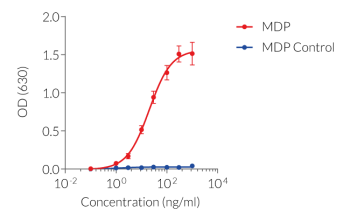MDP control
-
Cat.code:
tlrl-mdpcl
- Documents
ABOUT
Muramyldipeptide (L-L isomer, inactive)
MDP Control, the negative control for muramyl dipeptide (MDP), is an L-L isomer that does not activate NOD2. MDP is an immunoreactive peptide that is recognized by the cytosolic receptor NOD2 [1, 2].
Mode of action:
NOD2 recognition of MDP is stereospecific to the L-D isomer. The core structure required for recognition of NOD2 is MurNAc attached to L-Ala and D-isoGln. Replacement of L-Ala for D-Ala (or D-isoGln for L-isoGln) eliminates the ability of muramyl dipeptide to stimulate NOD2 [2]. MDP Control contains L-Ala and L-isoGln, and hence does not activate NOD2.
Key features:
- Negative control for MDP
- L-L isomer
- Each lot is thoroughly tested
![]() Read our review on NOD-Like Receptors
Read our review on NOD-Like Receptors
References:
1. Girardin S.E. et al., 2003. Nod2 is a general sensor of peptidoglycan through muramyl dipeptide (MDP) detection. J Biol Chem. 278(11):8869-72.
2. Inohara N. et al., 2003. Host recognition of bacterial muramyl dipeptide mediated through NOD2. Implications for Crohn’s disease. J Biol Chem. 278(8):5509-12.
All products are for research use only, and not for human or veterinary use.
SPECIFICATIONS
Specifications
C19H32N4O11
10 ng - 10 µg/ml
10 mg/ml in water
Cellular assays
Each lot is functionally tested and validated using cellular assays.
CONTENTS
Contents
-
Product:MDP control
-
Cat code:tlrl-mdpcl
-
Quantity:5 mg
1.5 ml sterile endotoxin-free water
Shipping & Storage
- Shipping method: Room temperature
- -20°C
- Avoid repeated freeze-thaw cycles
Storage:
Caution:
Details
NOD1 and NOD2
The cytosolic NOD-Like Receptors (NLRs, also known as NODs or NALP) are Nucleotide-binding Oligomerization Domain containing receptors. To date, 22 NLRs have been identified in humans and constitute a major class of intracellular pattern recognition receptors (PRRs) [1].
The founding NLR-family members NOD1 (CARD4) and NOD2 (CARD15) recognize distinct motifs of peptidoglycan (PGN), an essential constituent of the bacterial cell wall. NOD1 senses the D-γ-glutamyl-meso-DAP dipeptide (iE-DAP), which is found in PGN of all Gram-negative and certain Gram-positive bacteria [1, 2] whereas NOD2 recognizes the muramyl dipeptide (MDP) structure found in almost all bacteria. Thus NOD2 acts as a general sensor of PGN and NOD1 is involved in the recognition of a specific subset of bacteria. Both iE-DAP and MDP must be delivered intracellularly either by bacteria that invade the cell or through other cellular uptake mechanisms. Ligand-bound NOD1 and NOD2 oligomerize and signal via the serine/threonine RIP2 kinase through CARD-CARD homophilic interactions [3]. Once activated, RIP2 mediates ubiquitination of NEMO/IKKγ leading to the activation of NF-κB and the production of inflammatory cytokines. Furthermore, poly-ubiquitinated RIP2 recruits TAK1, which leads to IKK complex activation and the activation of MAPKs [4].
Genetic mutations in NOD2 are associated with Crohn’s disease, a chronic inflammatory bowel disease [5]. In addition, numerous studies have recently revealed that NOD1 and NOD2 have a close relationship with a variety of cancers via controlling proliferation, altering immunosurveillance, and interacting with tissue bacteria, including intestinal commensal intestinal microflora. Moreover, additional research into the mechanisms of NOD1 and NOD2 in cancers would shed light on the innate immunity-cancer relationship and provide intriguing targets for immunotherapy [6].
References:
1. Chamaillard M. et al., 2003. An essential role for NOD1 in host recognition of bacterial peptidoglycan containing diaminopimelic acid. Nat. Immunol. 4: 702-707.
2. Girardin S. et al., 2003. Nod1 detects a unique muropeptide from Gram-negative bacterial peptidoglycan. Science 300: 1584-1587.
3. Kobayash, K. et al., 2002. RICK/Rip2/CARDIAK mediates signalling for receptors of the innate and adaptive immune systems. Nature 416: 194-199.
4. Kobayashi K. et al., 2005. Nod2-dependent regulation of innate and adaptive immunity in the intestinal tract. Science 307: 731-734.
5. Ogura Y. et al., 2001. A frameshift mutation in NOD2 associated with susceptibility to Crohn’s disease. Nature 411: 603-606.
6. Wang D., 2022. NOD1 and NOD2 Are Potential Therapeutic Targets for Cancer Immunotherapy. Comput Intell Neurosci.;2022:2271788.
Structure of MDP Control:

DOCUMENTS
Documents
Technical Data Sheet
Safety Data Sheet
Certificate of analysis
Need a CoA ?
